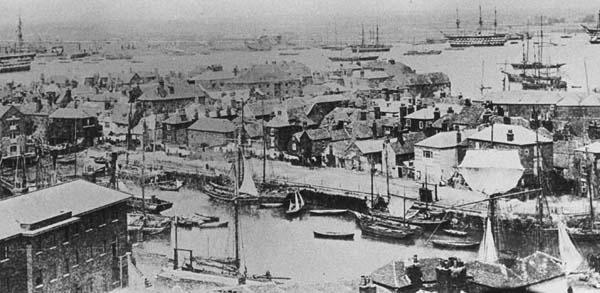
The Camber, Portsmouth
Historiographical debates surrounding sailors and sailortowns, has often focussed heavily on Atlantic contexts and seldom have they been considered beyond this, with sailors and sailortowns often viewed as ‘separate’ to land.[1] However, new research has highlighted the extent to which sailors and sailortowns were as much a part of urban settings as they were maritime ones. Historiographically, this presents a problem, how does one bridge the seeming void between Atlantic approaches, which tend not to reach too far inland, and urban approaches that seem to stop at the coastline? A ‘coastal history’ perspective offers a solution to this problem. Whilst it should not become a replacement, it does offer a mediating point, between the two approaches and histories. Whilst coastal peoples and areas have been studied before, namely through littoral and ‘seascape’ prisms, previous research has not been undertaken within a ‘coastal’ theoretical basis as discussed below.[2]
First coined by Isaac Land in 2007, ‘New Coastal History’, as an approach, provides an effective way to merge “green and blue histories” [3] in a way that proposes the two histories are not as mutually exclusive as they are often seen to be. The central premise of coastal history is that it takes the coastline, the coastal – urban borderland areas, as its focus, a combined urban and maritime space that has long been examined by geographers and economists but is often neglected by historians.[4] Coastal areas represent the intersection of land and water, allowing historians to see the tidal movement of people, socio-cultural exchanges and experiences.[5] This is particularly constructive to the study of sailors and sailortowns since, by their very nature, both were “coastal phenomena,”[6] located and shaped not just by maritime settings but also landed ones; ameliorating the spatial and socio-cultural visions of sailortowns and sailors. More widely, a coastal approach offers the historian fruitful and multifaceted ways in which to explore sailors and sailortowns from multiple perspectives, providing more diversity in the way encounters, exchanges and experiences are understood.
Thus, coastal history offers another way in which to navigate the intertwining, intersecting worlds and experiences of sailors and sailortowns that cross the realms of both Neptune and Gaia, illuminating the ever changing and shifting maritime-urban socio-cultural experiences that shaped and influenced, not just sailors and sailortowns, but port life and communities more widely. Taking a coastal approach to sailors and sailortowns allows for debates surrounding them to be progressed beyond maritime centred contexts. Crucially, coastal history as a methodological basis, presents an approach that acknowledges and understands sailors and sailortowns in relation to urban experiences alongside the sea-based experiences that they are already well understood to be influenced by. Ultimately, as Land persuasively suggests,
“Historians who cast their nets on the coast will catch considerable numbers of people whose lives and experiences would be missed by a scholar who trawls the oceans. In the end, there is simply more history to be written about the coast than about the deep blue sea.”[7]
For further discussion about Coastal History see Isaac Land’s ‘The Coastal History Blog’ here
References
[1] Isaac Land, “Tidal Waves: the New Coastal History”, Journal of Social History, vol. 40, no. 3, (2007), 731 – 743; 731 – 734, Isaac Land, War, Nationalism and the British Sailor, 1750 – 1850, (London: Palgrave Macmillan, 2009), see ‘Introduction’ and ‘Chapter 1,’ Glen O’ Hara, ““The Sea is Swinging into View”: Modern British Maritime History in a Globalised World”, English Historical Review, vol. 124, no. 5, (2009), 1109 – 1134. For an example of Atlantic contexts see, Marcus Rediker, Between the Devil and the Deep Blue Sea: Mercantile Seamen, Pirates and the Anglo – American Maritime World, 1700 – 1750, (Cambridge: Cambridge University Press, 1987).
[2] See for example, Peter Fricke, eds., Seafarer and Community: Towards a Social Understanding of Seafaring, (London: Croom Helm, 1973) and Karen Wigën, Jerry Bentley and Renale Bridenthal, eds., Seascapes, Maritime Histories, Littoral Cultures and Trans-oceanic Exchanges, (Honolulu: University of Hawaii, 2007) and John Mack, The Sea: a Cultural History, (London: Reaktion Books, 2011).
[3] Quote from Glen O’ Hara,, Britain and the Sea since 1600, (Basingstoke: Palgrave Macmillan, 2010), 7. For Land’s definition and suggestion as to labelling this approach, see Land, “Tidal Waves,” 732.
[4] For example see, Theo Notteboom, César Ducruet and Peter de Langen, Ports in Proximity: Competition and Coordination among Adjacent Seaports, (Aldershot, Ashgate, 2009), and Frederick Morgan and James Bird, Ports and Harbours, Second Edition (London: Hutchinson, 1958, [First Edition 1952).
[5] Land, “Tidal Waves,” 732.
[6]Richard Lawton and Robert Lee, “Port Development and The Demographic Dynamics of European Urbanisation” in eds. Richard Lawton and Robert Lee, Population and Society in Western European Port Cities, c. 1650 – 1939, (Liverpool: Liverpool University Press, 2002), 1 – 36; 3 – 5 and Robert Lee, “The Socio-economic and Demographic Characteristics of Port Cities: a Typology for Comparative Analysis”, Urban History, vol. 25, no. 2, (1998), 147 -172; 148 – 151.
[7] Land, “Tidal Waves,” 741.










Comments are closed.